Raeder emphasized that existing conditions made it
propitious for Weserubung to be executed as soon as
possible. He pointed out that naval preparedness was
complete; weather conditions, whatever they might be,
would pose no problem. The invasion should take place
soon, because U-boats on station in Norwegian
waters (Operation Hartmut) would have to return in
another three weeks for reprovisioning and refueling.
Raeder further suggested April 7 as W Day, for there
would be a new moon on that night. Since surprise was
of the essence, Raeder cautioned that the progressive
shortness of the northern nights would preclude an
invasion after April 15.
At the Fuhrer Conference of March 29, Raeder
again expressed concern that Weserubung be
accelerated; he then stated rather cryptically that the
Norwegian attitude was becoming more determined.
Although Raeder did not elaborate, he made it clear to
all present that conditions in the north were growing
more unfavorable to the Reich each day.
The Norwegian government was not completely
unaware of the course of events in both British and
German camps. Determined to preserve neutrality,
Norway attempted to give neither side the provocation
to intervene in Norwegian affairs.
Norway's Intentions
Contrary to Raeder's evaluation, Norway was
trying to keep her powerful neighbors in check by
following a middle course. Actually all three nations
were pursuing independent policies; unfortunately for
the Norwegians, they were the object of a power
struggle beyond their capacity to control or influence.
Trade agreements had little meaning without guns to
back them.
On April 1, Hitler signed the operational order for Weserubung; W Day was set for April 9, and zero hour for 0515. At 0200 on April 3, the first three ships of the lead-off groups (Ausfuhrstaffel) departed from Hamburg bound for Narvik. Their departure time, which was shrouded in secrecy, took place at an hour when the usually busy port was practically devoid of activity.
Despite all efforts to conceal invasion activity, Weseriibung was of such magnitude that it proved impossible to maintain complete secrecy.
The British Admiralty began to receive intelligence regarding German movements soon after the first ships of the Ausfuhrstaffel had sailed. The most significant report was from Copenhagen; the Admiralty was informed that ten German ships carrying a division of troops were proceeding on a northerly course out of the Baltic, their reported destination Narvik. While
passing this information to Admiral Sir Charles Forbes, the Commander of the Home Fleet, the Admiralty described its validity as doubtful.
A misconception was responsible for the disbelief
in German intentions. British naval doctrine
eschewed landing a military force on a hostile
shore without assurance of firm control of the sea
contiguous to the area to be invaded; it was assumed
the Germans pursued a similar policy.
More Reports
Reports signifying unusual shipping activity
continued to be received by the Admiralty. By April 8,
nineteen British and Allied submarines were on station
off the Norwegian coast; they reported an unusual
number of ships moving north under neutral flags,
but were unable positively to identify any of the
shipping as German troopships. Between April 3 and
7, twenty-two vessels, all the ships comprising the
Ausfuhrstaffel and Seetransportstaffel (supply ships
for the first wave), had departed from Hamburg and
Stettin. On April 3 and 4, two large tankers departed
from Wilhelmshaven, and on April 6, a small tanker left
Hamburg. Another large tanker, Jan Wellem, departed
from the Murmansk area for Narvik on April 6.
On April 8 the second wave of eleven ships of the
Seetransportstaffel departed from Gotenhaven and
Konigsberg. Between midnight April 7 and 0530 April 8
the Kriegsschiffstaffeln (the striking force) left
Wesermunde, Cuxhaven, Wilhelmshaven and
Swinemunde. This force consisted of a pocket
battleship, two battle cruisers, two heavy cruisers, four
light cruisers, fourteen destroyers, eight torpedo boats,
four minesweepers, and seven auxiliary vessels. Forty-
two ships in all, the warships constituted almost the
entire German Navy. By 0600 on April 8, the number
of German ships poised off different points of the
Norwegian coast totaled 107. In manpower and tonnage the German armada
represented the largest seaborne operation in history.
Closing the Coast
At the same time the German fleet was
approaching W Day jump-off positions, the British
battle cruiser Renown and a force of fourteen
destroyers, the Operation Wilfred Force, were closing
the Norwegian coast. While the Wilfred destroyers laid
minefields off the approaches to Bodo and Stadlandet,
a contingency force lay in readiness at Rosyth and the
mouth of the Clyde. Although the Admiralty did not
anticipate German initiative in Norway, they did expect
enemy intervention once it became obvious to the
German High Command that Operation Wilfred posed
a threat to the Reich's source of iron ore. Should the
contingency force be used, its operational order was
designated Plan R4; its purpose was to counteract
German landings in Norway by landing British troops
at key locations.
Operation Wilfred had been modified considerably
since its inception. Originally it had called for troop
landings subsequent to the mine laying operations.
However, by the time Wilfred was implemented the
War Cabinet had decided that no troop landings would
take place unless the Germans landed first or
demonstrated an intent of violating Norwegian
neutrality. The units designated to carry out R4 would
be the 146th and 148th Infantry Brigades. Of the six
battalions comprising the two brigades, two battalions
were assigned to seize Stavanger, two were set for
Bergen, and one each would take Trondheim and
Narvik.
The R4 expedition would be transported in
troopships with an accompanying light cruiser
force. Planning for the operation had been
conducted haphazardly, and troops, equipment and
shipping were assembled hastily. While the force to be
landed numbered 18,000 men, troop and equipment
organization was poor; it will be seen later how the
poor organization contributed to British failure at
Narvik, Namsos, and Aandalsnes.
According to Norwegian Admiralty records two
reports were received prior to W Day that should have
been construed as definite warnings of impending
German aggression. On the night of April 7, the pilot
station at Kopervik reported that the steamer
Skagerrak bound for Trondheim was carrying cargo
cases marked "Wehrmacht." The second warning
occurred next aftemoon. The Polish submarine Orzel
torpedoed and sank the German steamer Rio de
Janeiro off Lillesand. Many of the survivors rescued by
Norwegian fishemmen were wearing German army
uniforms; some stated that they were bound for
Bergen for the purpose of aiding the Norwegians
against the British.
Despite the alert, however,
coastal forts were not authorized to mine the fjords and
harbor entrances, and the decision to mobilize was
postponed; nor were steps taken to protect the airfields
against capture by airborne troops. It is true that
neither the British nor the Norwegians took decisive
steps in the face of the two ominous warnings, but
Churchill is wrong to assert that no action was taken
by either nation as a result of the incidents which
occurred approximately fourteen hours before zero
hour on W Day.
Trojan Horse Myth
One of the myths surrounding the Norwegian
campaign concerns German "Trojan horses." Although
dramatic in its concept, the only phase of the operation
that resembled an attack from within was the role
assigned to the Ausfuhrstaffel and four ships of the
Tankerstaffel.
The eleven ships in this group were scheduled to
arrive off their destination ports at 0500 on W Day; the
attack was to begin half an hour later. These ships
carried heavy equipment, ordnance, provisions, and
fuel, not troops to seize radio stations and key harbor
installations. The supply ships and tankers were part of
the main attack and not a planned thrust from within
the Norwegian harbors.
Churchill contributed to the myth by writing that
supplies and ammunition were carried to Narvik in
empty ore ships; no ore ships participated in
Weserubung In his memoirs Harold Macmillan
compounds this error by reiterating Churchill's twenty-year old statement. Because of the notoriety
surrounding Quisling's treachery, it was believed in
1940 that peaceful German freighters, which had
allegedly been lying in Norwegian ports days before the
attack began, suddenly disgorged hordes of fully armed
soldiers who had been hiding below decks.
Again, the idea is imaginative but not realistic. In
the realm of shipping and trade, where every vessel is
known and registered, the arrival of cargo ships in a
port is known and expected; ships do not lie in port
unnoticed by the authorities. Discovery of one such
"Trojan horse" would have betrayed the entire
Weserubung operation. The German High Command
would not have risked the success of the attack with
such a harebrained scheme.
Germans Sighted
At 0800 on April 7, several German ships traveling in
convoy were sighted off the western entrance of the
Skagerrak by a British reconnaissance aircraft; the
ships were part of the Kriegsschiffstaffeln. In the early
afternoon a force of twelve Blenheim aircraft attacked
the warships, but failed to do any damage. With the
knowledge that the German Navy was at sea in force,
Admiral Forbes and the Home Fleet sailed from Scapa
Flow that same evening.
As continuing reports of German ship movements
were received, other units were ordered to sea by the
Admiralty to augment Forbes' force. Additional vessels
included the four Rosyth cruisers aboard which the R4
troops had been embarked; these soldiers were hastily
put ashore before the ships sailed. The sudden
abandonment of Plan R4 came as a surprise to Forbes,
who was convinced the many sightings of German
shipping was evidence that an assault upon Norway
was in progress, and that the very conditions for which
R4 had been devised now existed.
The Admiralty, in spite of accumulating evidence,
judged that it was the Germans trying to work the
Gneisenau and Scharnhorst into the Atlantic trade
routes. When an invasion is in progress the primary
objective of the defending fleet is diverted from enemy
warships to transports. After the war Admiral Forbes
stated that he recognized the German intentions during
the early stages of Weserubung; he felt that pursuit of
the German battle cruisers had lost its purpose and
was, in fact, aiding the enemy plan.
On the morning of April 7, the southern minelaying
force executing Wilfred was recalled because of the
German warships reported in the south. The force
laying the field off Bodo, however, was allowed to
continue operations; it consisted of four minelaying
destroyers accompanied by HMS Renown and eight
other destroyers under the command of Admiral
Whitworth. By early morning of April 8, the minefield
was in place, and Whitworth's force remained in the area to guard the entrance to Vestfjord.
During the night of April 7-8, Groups 1 and 2
of the Kriegsschiffstaffeln traveling together
approached their destinations, Trondheim and
Narvik. Heavy seas, while helping to screen German
ships from observation, made it difficult for the fourteen
destroyers to maintain the twenty-six knot speed of
Gneisenau, Scharnhorst and Hipper. By morning of
April 8, the force was scattered, and contact with
several of the destroyers had been lost. Under these
conditions the destroyer Bernd von Arnim encountered
the British destroyer Glowworm off Trondheim at
0820. A running battle lasted until 1024, when the
Glowworm was sunk by the Hipper which had come to
the aid of the Bernd von Arnim. Admiral Whitworth
had first tried to join battle with the rest of his force but,
assuming that Glowworm's adversaries were bound for
Narvik, he changed course.
Thus, Whitworth sailed to a position off the
entrance to Vestfjord, where he hoped to intercept the
German force. While the battle was raging, Forbes and
the Home Fleet continued to sail in a northerly
direction. By this time Groups 1 and 2 had separated,
and Group 1, reduced to ten destroyers, was sailing
directly toward Whitworth's force covering the
approaches to Narvik; Forbes and the Home Fleet
were closing Group 1 from the south. Although neither
the Admiralty nor the fleet commanders were certain a
German force was in the pocket, Group 1 was not only
trapped between two British forces, but Renown,
standing off the Lofoten Islands, was also ordered to
close the German force from the west.
Saved from Destruction
On the afternoon of April 8 an incident occurred
which was to save Group 1 from destruction. At 1430 a
British flying boat sighted Hipper and four destroyers
sailing westward; this was Group 2, and the
westerly course was merely a maneuver to coordinate
the attack on Trondheim with W Day Zero Hour.
Knowledge of Group 2's location, however, caused
Admiral Forbes to change the Home Fleet's course
from northeast to northwest in an effort to intercept.
Intelligence that a German flotilla was steering on a
westward course confused Forbes, who to this time
had had a fairly clear estimate of the situation.
Forbes changed course again, after determining that he had no
chance to intercept the German force northwest of the Home Fleet. Before turning south Forbes ordered Renown and Admiral Whitworth's destroyers to
intercept Group 2, which was still on a westerly
course; it was not apparent to the Admiralty or the
fleet commandes that Groups 1 and 2 had separated.
Admiral Whitworth was ordered to leave his position
guarding the entrance to Vestfjord and move his
destroyers westward to set up a picket line across the
North Sea; it was assumed that the German force
might be trying to break out of the North Sea into the
Arctic Ocean with the goal of reaching the Atlantic
trade routes.
The order for Whitworth to leave position did not
originate with Admiral Forbes The order came directly
from Whitehall and was passed on through the
Admiralty; it was a case of governmental interference
in a purely naval matter. The departure of Whitworth's
destroyers left the approaches to Vestfjord unguarded.
On the night of April 8, the ten destroyers of Group 1
carrying two thousand troops slipped into Vestfjord
unnoticed.
W Day Zero Hour began with a coordinated naval
and air assault on Norway's principal port, population,
and industrial centers. For purposes of clarity each
attack will be examined separately from north to south.
Narvik Captured
The ten destroyers constituting Group 1 proceeded
through Vestfjord and into Ofotfjord without being
observed. At 0530 on April 9 this force appeared off
Narvik, where the Germans were finally challenged by
the Eidsvold and Norge, two coastal defense ships,
which were torpedoed and sunk. After this brief
engagement the destroyers disembarked their troops
along the quays of Narvik harbor. General Eduard
Dietl, commanding the Third Mountain Division, went
ashore with the first troops, met the local Norwegian
commander, and demanded immediate surrender.
Caught by surprise, the Norwegians were in no position
to resist; they capitulated without resistance. At 1810
Dietl reported that Narvik was in German hands.
Despite successful occupation of the city, the
German position was precarious. Much of the
occupying force's equipment, transported by the
destroyers, had been lost or jettisoned during the stormy
passage north. Accentuating the scarcity of supplies
and fuel, of al1 the vessals destined for Narvik to
support the invasion, only the Jan Wellem arrived safely.
While Narvik was being occupied, Renown and Admiral Whitworth's force of nine destroyes
encountered Gneisenau and Scharnhost en route to their patrolling position in the upper North Sea. The sighting took place at 0337, and the battle that resulted, fought in heavy seas, caused the two German ships to flee northward after the Gneisenau's main armament control system had been put out of action. Because of the slowness of her escorting destroyes, Renown was unable to keep up with the German battle cruises and by 0630 contact had been lost.
Group 2, which had been crusing off Trondheim on
April 8, closed the entrance to Trondheim Fjord at 0300
the next moming. The shore batteries were not caught
by surprise, although their fire was only desultory.
Despite the alarm, Group 2 was able to pass through
the entrance to Trondheim Fjord without sustaining
damage. The situation within the harbor at Trondheim
was similar to that at Narvik; the troops were
disembarked without incident, and there was no
resistance w,ithin the city. By nightfall the city was
reported secured.
Fog proved beneficial to Group 3, whose task was
the seizure of Bergen. Here the shore batteries were
most effective. Despite the covering fog, the coastal
guns inflicted damage upon the light cruiser Konigsberg
and the gunnery training ship Bremse as these ships
approached the harbor entrance. Had there been
greater visibility, the accuracy of the shore batteries
might have been aufficient to turn away the attacking
German force. The ships of Group 3 were able to close
the coastline, however, and after a brief duel with the
Norwegian guns, were able to pass into Bergen harbor,
where the troops were disembarked. By 0620 Bergen
was in German hands; there had been minimal resistance ashore. German losses were slight, although Konigaberg, which had taken three hits, was rendered unseaworthy.
Group 6 secured Egersund without incident. Group
4 was assigned the double task of taking Kristiansand
and Arendal; the latter was captured by a single
torpedo boat. Fog proved to be a serious hazard in the
assault on Kristiansand. Because of poor visibility the
Germans were delayed in entering the fjord. Surprise
was lost when at 0600 a Norwegian aircraft sighted the
German ships off the entrance to the fjord. The
commander of the German ships had to request air
support to neutralize the shore batteries. By 1100 the
coastal guns had been silenced by several Luftwaffe
strikes, and by early afternoon Kristiansand was in
German hands.
The first stage of the operation was designed to
gain footholds; additional troops and supplies would be
required if the Germans hoped to hold what they had
taken so easily. Because the German Navy could not
possibly protect merchantmen from the Royal Navy,
supplying of the new bases along Norway's west coast
by sea was out of the question. There was only one
altemative -- the protected route between the Baltic
ports and Oslo.
From bases in northern Jutland the Luftwaffe
maintained complete air superiority over the narrow
waters of the Kattagat and Skagerrak; except for
submarine penetration, the Royal Navy would not dare
enter these waters. The prime reason for Oslo's
importance to the High Command was that Norway's
capital was the only port on the southem coast which
was capable of handling the logistics of an invading
army.
Oslo was not to be a bloodless conquest for the Wehrmacht. During the initial stages everything went well for the Germans.
Group 5 encountered little resistance and passed
the entrance to Oslo Fjord just after midnight on the
night of April 8-9. Group 5 was the strongest of the
attacking formations and, possibly because of this, the
flotilla proceeded boldly up the fiord toward its
destination. The only resistance encountered at the mouth was offered by a Norwegian patrol boat, Pol III, which was torpedoed and sunk. At 0440 Group 5 proceeding in column reached the Drobak Narrows, ten miles south of Oslo.
Fortress
The narrows were protected by a system of
defenses dominated by the Oscarsborg Fortress. In
addition to the fortress the Narrows were defended by
280 mm. guns located at Drobak and Kaholm, two
small towns on the banks above the Narrows; Kaholm
also maintained a land torpedo battery. Ignoring several
signals from shore, the German column proceeded into
the Narrows, whereupon the Norwegian guns opened
fire at point blank range. The Blucher, leading the
column, was hit several times by gunfire before the
heavy cruiser was struck by two torpedoes fired from
the Kaholm battery.
The warships, however, held up by the determined
resistance of the batteries located at the Narrows, did
not arrive in Oslo harbor until 1145 on April 10. Group
5 had been severely mauled, and for one of the
warships the ordeal was not over. On April 11, on her
return journey to Kiel, the Lutzow was torpedoed and
severely damaged by a British submarine. The damage
was so extensive it was necessary to tow the pocket
battleship back to Germany for repairs, where the
Lutzow remained out of commission for the remainder
of 1940. The Kriegsmarine had paid dearly for the
capture of Oslo.
By early afternoon of April 9, the Wehrmacht had
succeeded in establishing control at every point of
attack. Despite the several warnings surprise had been
almost complete.
It was not only the British and Norwegians who
were taken by surprise. The Italians, allied to Germany
by the Pact of Steel, had not been privy to
Weserubung planning, and were informed of events
only after the invasion was in progress. Despite
Mussolini's seeming enthusiasm, it was apparent that
this was the first he had heard of Weserubung. While
Ciano privately expressed sympathy and admiration for
the Norwegians, the Duce stated that the disorder in
Europe offered Italy opportunities for expansion.
By April 10, the situation in Norway had not been
clarified to those active in the British government.
Harold Nicolson recorded that the Foreign Office was
languishing in the depths of gloom. While the situation
was clouded to those in the government, the fleet
commanders were fully aware of what had transpired
in Norway.
More Weserubung
This article appears in MagWeb (Magazine Web) on the Internet World Wide Web.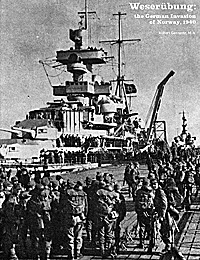 All the details
in the planning of Weserubung had been completed by
March, 1940; there remained only the setting of the
precise date and hour. Concern about British
intervention in Norway, which had subsided when the
Finns had capitulated, was renewed when German
Naval Intelligence reported that enemy submarines
were concentrated west of the Skagerrak. At the
March 26 Fuhrer Conference Raeder stated that he no
longer felt that British intervention in Norway was
imminent. Nevertheless he insisted that German forces
would have to occupy Norway sooner or later.
All the details
in the planning of Weserubung had been completed by
March, 1940; there remained only the setting of the
precise date and hour. Concern about British
intervention in Norway, which had subsided when the
Finns had capitulated, was renewed when German
Naval Intelligence reported that enemy submarines
were concentrated west of the Skagerrak. At the
March 26 Fuhrer Conference Raeder stated that he no
longer felt that British intervention in Norway was
imminent. Nevertheless he insisted that German forces
would have to occupy Norway sooner or later.
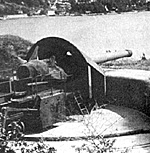 Apprised of the incident, shortly after 1700 on
April 8, London warned the Norwegian government
that an attack was imminent. The warning was
discussed by the Norwegian Parliament and Cabinet
that evening in Oslo. As a result, coastal fortifications were alerted, a precaution which was to cause the Germans heavy losses. At right, Norwegian coastal gun.
Apprised of the incident, shortly after 1700 on
April 8, London warned the Norwegian government
that an attack was imminent. The warning was
discussed by the Norwegian Parliament and Cabinet
that evening in Oslo. As a result, coastal fortifications were alerted, a precaution which was to cause the Germans heavy losses. At right, Norwegian coastal gun.
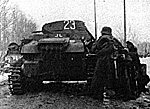 One of the four ships of the Ausfuhrstaffel was forced to put into Bergen, and the
other three were sunk or had to be scuttled to avoid capture. Because of these sinkings Dietl suffered from an almost total lack of equipment and. supplies. The most serious loss was the tanker which was to have assisted the Jan Wellem in refueling the destroyes, whose bunkers were almost empty after the long journey north; now they would be compelled to remain at Narvik until refueled.
One of the four ships of the Ausfuhrstaffel was forced to put into Bergen, and the
other three were sunk or had to be scuttled to avoid capture. Because of these sinkings Dietl suffered from an almost total lack of equipment and. supplies. The most serious loss was the tanker which was to have assisted the Jan Wellem in refueling the destroyes, whose bunkers were almost empty after the long journey north; now they would be compelled to remain at Narvik until refueled.
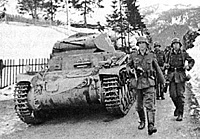 The key to success of Weserubung lay in the early capture of Oslo. While control of Narvik was important, the German High Command was aware that after the initial landings the northern port could not be supplied by sea, in view of the superiority of the Royal Navy. During the initial phase it had been possible to bring troops and supplies to all of Norway's major ports.
Most of the troops and supplies committed to Norway, however, were still in the German Baltic ports.
The key to success of Weserubung lay in the early capture of Oslo. While control of Narvik was important, the German High Command was aware that after the initial landings the northern port could not be supplied by sea, in view of the superiority of the Royal Navy. During the initial phase it had been possible to bring troops and supplies to all of Norway's major ports.
Most of the troops and supplies committed to Norway, however, were still in the German Baltic ports.
 Within half an hour the Blucher had capsized (see photo at right) and
sunk with heavy loss of life, and the remainder of the
German column was forced to withdraw. The
Weserubung timetable had been upset: Before the
naval column could proceed north, the fortress system
had to be taken by ground assault. This delay enabled
the Norwegian government to escape north, taking
Norway's gold reserves with them; the battle fought at
the Narrows had gained the Allies valuable time.
Within half an hour the Blucher had capsized (see photo at right) and
sunk with heavy loss of life, and the remainder of the
German column was forced to withdraw. The
Weserubung timetable had been upset: Before the
naval column could proceed north, the fortress system
had to be taken by ground assault. This delay enabled
the Norwegian government to escape north, taking
Norway's gold reserves with them; the battle fought at
the Narrows had gained the Allies valuable time.
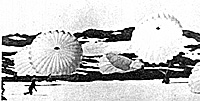 Ultimately Oslo was to fall as the result of a daring
airborne assault. Paratroopers, closely followed by Ju
52 transport planes carrying more troops, captured
Fornebu Airfield just outside 0810. After meeting only
slight resistance at the airfield, the Germans marched
into Oslo led by a military band. Whereas a bluff had
not worked at the Narrows, this one did; Oslo was in
German hands by noon April 9.
Ultimately Oslo was to fall as the result of a daring
airborne assault. Paratroopers, closely followed by Ju
52 transport planes carrying more troops, captured
Fornebu Airfield just outside 0810. After meeting only
slight resistance at the airfield, the Germans marched
into Oslo led by a military band. Whereas a bluff had
not worked at the Narrows, this one did; Oslo was in
German hands by noon April 9.
Back to Conflict Number 3 Table of Contents
Back to Conflict List of Issues
Back to MagWeb Master Magazine List
© Copyright 1998 by Dana Lombardy
Other military history articles and gaming articles are available at http://www.magweb.com
E-mail MagWeb if you find broken links, missing graphics, or other problems.